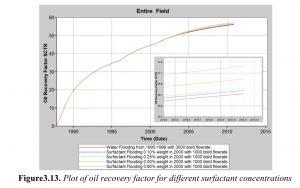Numerical Approach for Enhanced Oil Recovery with Surfactant Flooding using STARS (CMG)
摘要:在传统的采油方法(一次或二次采油)之后,有超过一半的地层原油仍然还剩余在地下。提高石油采收率主要是对地层中未被采出的剩余油进一步开发。有很多提高石油采收率的方法是通过向储层注入流体来提高原油产量。在这篇论文中,提高石油采收率的方法是化学注入,具体使用的化学品是表面活性剂。表面活性剂驱是利用表面活性剂吸附在油水界面,将油水界面的界面张力降低到10^-2 mN/m及以下的超低值。由于界面张力低,原油更容易流动,油水相对渗透率增加,反过来又影响储层岩石的润湿性,变得更加偏向水湿。因此,更多的剩余油能被驱替出来,原油采收率提高。该研究中的储层是位于利比亚的一个油田。使用cmg对该油田进行了油藏数值模拟。从模拟的结果来看,从1987到1995,因为油田有很强的水驱能量,故采用衰竭式开采进行了一次采油。从1995开始,水驱被模拟为二次采油。当以3000桶/天向地层注水持续5年到2000,获得了最佳的结果。从2000开始,油藏进行表面活性剂驱。对不同的表面活性剂浓度、流速以及驱替时间进行了敏感性分析从结果来看,进行6年的表面活性剂驱,3000桶/天的注入速度和0.8%浓度比重是最佳的表面活性剂驱条件,在最佳的表面活性剂条件下可以额外获得167167桶原油。
Abstract: There is more than half of the original oil of the reservoir which is entrapped and immobile after orthodox recovery methods (primary and secondary recovery methods). Enhanced Oil Recovery (EOR) is essential to further extract the unrecovered residual oils. There are many EOR methods available to improve oil production by injecting fluids into the reservoir. In this thesis, the EOR method used is chemical injection and the specific chemical used is surfactant. Surfactant flooding utilises surface active agents (or surfactants) to adsorb onto oil-water interface and reduce their interfacial tension (IFT) to an ultralow value of 10-2 mN/m and below. Due to the low IFT, oil is readier to be mobilised and its relative permeability with water is increased and this in turn alters the wettability of the reservoir to become more water-wet. Henceforth, more residual oil can be displaced yielding a greater oil recovery. The reservoir used in this research is an oil field located in Libya. A numerical approach simulation is done on this field using STARS which is a software package by Computer Modelling Group (CMG). From the simulations executed, primary recovery is done from 1987 till 1995 using natural depletion as the reservoir has a strong water drive. Water flooding method is simulated as the secondary recovery method from year 1995. The optimum results are obtained when water is flooded at a rate of 3000 bbl/day and for 5 years till year 2000. From year 2000 onwards, the reservoir undergoes surfactant flooding. Sensitivity analyses are done for different surfactant concentrations, flow rates and flooding periods. From the results, surfactant is flooded for 6 years (2000-2006) with a flow rate of 3000 bbl/day and concentration of 0.8 % weight. It is proven that with optimum surfactant flooding conditions, an extra of 167,167 barrels of oil is recovered.
Keywords: Enhanced oil recovery, surfactant flooding, tertiary recovery, STARS, simulation, interfacial tension, EOR, IFT, and CMG.


